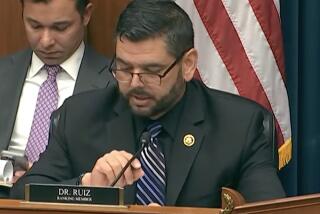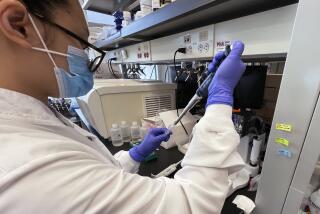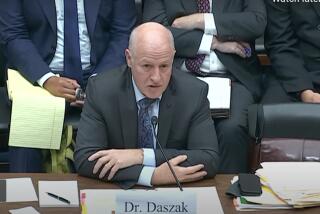Homeland Security faulted for BioWatch biological defense system
WASHINGTON — The U.S. Department of Homeland Security has rushed to acquire a new, multibillion-dollar version of the BioWatch system for detecting biological attacks without establishing whether it was needed or would work, according to a new report by a nonpartisan investigative arm of Congress.
The report by the Government Accountability Office says Homeland Security should reevaluate the need for the overhaul while determining whether it makes financial sense. The department has spent more than $150 million developing the new generation of biological sensors.
The report comes as Homeland Security officials try to maintain support in Congress for both BioWatch and the long-pursued makeover, called Generation 3. The report’s findings — which fix blame on both the George W. Bush and Obama administrations — are scheduled to be discussed Thursday during a hearing by two House subcommittees.
The Times obtained a draft of the report, which has yet to be publicly released.
Homeland Security has failed to follow “good acquisition practices,” the report said, and has not adequately justified Generation 3, which would cost an estimated $3.1 billion during its first five years of operation. The existing BioWatch system has cost taxpayers about $1 billion.
The Times reported in July on extensive problems with the existing system and Generation 3. The existing system, first deployed in 2003, relies on units installed in cities around the country that pull air through filters, which technicians collect and bring to public health labs for analysis. The Generation 3 sensors would be automated.
The existing units have been plagued by false alarms; the GAO report confirmed “more than 100.” As for Generation 3, field and lab tests found that prototypes of the new technology were not durable or sensitive enough to reliably detect a biological attack.
The Generation 3 automated sensors — each a so-called lab in a box — would sample the air and signal to authorities whether they detect the presence of anthrax or at least four other pathogens. The GAO report suggested that in the aftermath of Sept. 11, 2001, and the subsequent anthrax letter attacks, Homeland Security officials bypassed the department’s own guidelines in acquiring the original BioWatch system and planning the Generation 3 overhaul.
“None of these officials could describe what processes, if any, the department followed to determine that Gen-3 was a justified need,” the report said.
The GAO found that, as of early 2008, Homeland Security leaders, not identified by the report, “had established a course” for acquiring the technology “in advance of any efforts to define the mission.”
In October 2009, an Obama appointee at the department, also unnamed, supported the Generation 3 procurement without “significant data necessary” for the decision, according to the report. “In the absence of complete and reliable information, DHS had limited assurance that the acquisition would successfully deliver the intended capability within cost and on schedule.”
The report’s findings are at odds with past public statements by Homeland Security officials. For instance, a department undersecretary, Jay M. Cohen, told a House committee in February 2007 that Generation 3 would probably be “four times cheaper to operate,” the GAO reported.
“The total annual cost to operate Gen-3 is estimated to be about four times more than the cost of the existing” BioWatch system, the report said.
On March 29 of this year, Cohen’s successor, Dr. Alexander Garza, told a congressional panel that the development of Generation 3 was on track and “right where it needs to be.”
The report said that Homeland Security has commissioned a federal advisory group, called the Homeland Security Institute, to help assess the Generation 3 technology. Although the assessment was supposed to be completed in July, the GAO reported that Homeland Security “has not provided us with a copy of the study or responded to requests to provide an updated timeline for the study.”
As of now, the GAO said, “critical information related to both the costs and benefits of the planned Gen-3 approach remains to be explored.”
A spokesman for Homeland Security, Peter Boogaard, said he was not in a position to comment on the report, noting that it had not been made public.
President George W. Bush unveiled BioWatch in his 2003 State of the Union address, saying it would “protect our people and our homeland” against a rogue state or terrorist group. Since then, the Bush and Obama administrations have deployed detection equipment in more than 30 U.S. cities and at major spectator events, including Super Bowls and national political conventions.
The existing system’s repeated false alarms have triggered tense, high-stakes deliberations over whether to order mass evacuations, distribute emergency medicines or shut down major venues. In each case, health authorities decided, sometimes with great trepidation, to disregard BioWatch. No evidence of an intentional release of a pathogen has ever been found.
That history has caused state and local health officials to call the system ill-conceived or unworkable. Scientists at the Centers for Disease Control and Prevention told White House aides last year that they would not release emergency medications based solely on a BioWatch alert. And federal officials have given up plans to deploy the system in airports for fear of needlessly disrupting travel.
Most of the documented false alarms have involved the supposed detection of tularemia, a potentially lethal bacterium. On the closing day of the 2008 Democratic National Convention in Denver, for example, BioWatch signaled the presence of tularemia at the convention site, threatening to disrupt plans for Barack Obama’s speech accepting his party’s presidential nomination.
After six hours of deliberations and further testing, state health officials decided that the alert had been erroneous, and Obama gave his speech on schedule.
More to Read
Sign up for Essential California
The most important California stories and recommendations in your inbox every morning.
You may occasionally receive promotional content from the Los Angeles Times.











